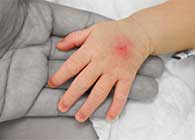December 2015
Normal-weight central obesity: implications for total and cardiovascular mortality
Karine R. Sahakyan et al. Annals of Internal Medicine. Doi:10.7326/M14-2525
There appears to a difference in the pathology associated with central obesity when a person’s BMI is normal. This study examined total and cardiovascular mortality in such instances. In all 15,184 adults aged 18 to 90 years were enrolled in the study. It was found that persons with normal-weight but with central obesity had the worst long-term survival. The authors conclude that normal-weight central obesity was associated with higher mortality than BMI-defined obesity, particularly in the absence of central fat distribution.
http://annals.org/article.aspx?articleid=2468805
Health economic burden that wounds impose on the National Health Service in the UK
Julian F Guest et al. BMJ. Doi:10.1136/bmjopen-2015-009283
This paper estimated the prevalence of wounds managed by the NHS in 2012/2013 and the annual levels of healthcare resource use that was attributable to their management along with the corresponding costs. The study looked at the records of patients in The Health Improvement Network (THIN) Database. The records of 1,000 adult patients who had a wound in 2012/2013 (cases) were randomly selected and matched with 1,000 patients with no history of a wound (controls). Patients’ characteristics, wound-related health outcomes and all healthcare resource use were quantified and the total NHS cost of patient management was estimated at 2013/2014 prices. The paper presents the sobering statistic that there were an estimated 2.2 million wounds managed by the NHS in 2012/2013, and that annual levels of resource use attributable to managing these wounds and associated comorbidities included 18.6 million practice nurse visits, 10.9 million community nurse visits, 7.7 million GP visits and 3.4 million hospital outpatient visits! The annual NHS cost of managing these wounds and associated comorbidities was £5.3 billion! This was reduced to between £5.1 and £4.5 billion after adjusting for comorbidities. The authors also note that because wound management is predominantly a nurse-led discipline, 30% of the wounds lacked a differential diagnosis, which is indicative of practical difficulties experienced by non-specialist clinicians. Not surprisingly nutritional deficiency and diabetes were independent risk factors for non-healing.
http://bmjopen.bmj.com/content/5/12/e009283.short
Insulin’s role in diabetes management: after 90 years, still considered the essential “black dress”
William T. Cefalu et al. Diabetes Care. Doi: 10.2337/dci15-0023
This opening article from the Diabetes Care’s series on insulin provides an overview of their collated articles. It is an informative timeline of changes in insulin therapy. The authors dramatise the continuing role of insulin in the management of diabetes by proposing an analogy from the world of clothing and fashion: Insulin is and will remain the simple “black dress” that will never be out of fashion, can go with almost anything, and remains the basis of one’s wardrobe. Just like the “black dress,” by simple additions or modifications it can be adapted to nearly all occasions. All in all, this is an accessible bite-size retrospective and an insight into future uses. The authors summarise it in the following words: “it is apparent that insulin has come a long way in over 90 years. Although it has always been the mainstay of type 1 diabetes treatment, we recognise now its effectiveness and safety in type 2 diabetes and continue to learn to use it in new ways. To a great extent, the newer classes of glucose-lowering agents are being studied as “add-on” tactics on a background of insulin rather than as a replacement for insulin in subjects with type 2 diabetes. Thus, we think insulin is and will continue to hold the place of the “black dress” among therapies … meeting a basic need, never out of fashion, and always adaptable to everyday needs”
http://care.diabetesjournals.org/content/38/12/2200.full
Impact of real-time continuous glucose monitoring use on glucose variability and endothelial function in adolescents with type 1 diabetes.
Milena Jamiołkowska et al. Journal of Diabetes Research. Doi: http://dx.doi.org/10.1155/2016/4385312
The aim of the study was to assess the usefulness of real-time continuous glucose monitoring (RT-CGM) as an educational tool to reduce glycaemic variability in order to improve endothelial function in adolescents with T1DM. For one-month CGM sensors were used in forty patients (aged 14.6 years), and parameters of glycaemic variability were analyzed during first and last sensor use, together with brachial artery flow-mediated dilatation (FMD) to assess endothelial function. In the whole group, FMD improvement was found (10.9% to 16.6%,), together with decrease in all studied glycaemic variability parameters. In patients with HbA1c improvement compared to the group without HbA1c improvement, we found greater increase of FMD (12% to 19%, versus 8.2% to 11.3%,) and greater improvement of glucose variability. The authors conclude that RT-CGM can be considered as an additional tool that offers adolescents with T1DM the quick reaction to decrease glycaemic variability. Although this was a short time observation, the authors suggest that such an approach can influence long-term improvement in endothelial function and a reduction of the risk of future cardiovascular disease.
http://www.hindawi.com/journals/jdr/2016/4385312/
Consequences of comorbidity of elevated stress and/or depressive symptoms and incident cardiovascular outcomes in diabetes
Doyle M. Cummings et al. Diabetes Care. Doi: 10.2337/dc15-1174
This study evaluated the impact of depressive symptoms and/or stress on adverse cardiovascular (CV) outcomes in individuals with diabetes compared with those without diabetes. The cardiovascular outcomes recorded included stroke, myocardial infarction/acute coronary heart disease, and CV death over a median follow-up of 5.95 years. There were 22,003 adults in the study (4,090 with diabetes) with a mean age of 64 years. It was found that elevated stress and/or depressive symptoms were more common in subjects with diabetes, and that elevated stress or depressive symptoms were associated with a significantly increased incidence of and CV death in subjects with diabetes but not in those without diabetes.
http://care.diabetesjournals.org/content/early/2015/11/04/dc15-1174.short
Effect of metformin added to insulin on glycemic control among overweight/obese adolescents with type 1 diabetes
Ingrid M. Libman et al. JAMA. Doi:10.10 01/jama.2015.1617
This study assessed the efficacy and safety of metformin as an adjunct to insulin in treating overweight adolescents with type 1 diabetes. In the study 140 subjects were randomised to receive metformin or placebo. Primary outcome measured was change in HbA1c from baseline to 26 weeks. Secondary outcomes included total daily insulin, BMI, waist circumference, body composition, blood pressure, and lipids. It was discovered that at 13-week follow-up, reduction in HbA1c was greater with metformin than placebo, but this differential effect was not sustained at 26-week follow up when mean change in HbA1c from baseline was 0.2% in each group. However, at 26-week follow-up, total daily insulin was reduced by at least 25% from baseline among 23% of participants in the metformin group vs 1% of participants in the placebo group. Also 24% of participants in the metformin group and 7% of participants in the placebo group had a reduction in BMI score of 10% or greater from baseline to 26 weeks. The conclusions were that among overweight adolescents with type 1 diabetes, the addition of metformin to insulin did not improve glycemic control after 6 months. Of the multiple secondary end points, the findings favored metformin only for insulin dose and measures of adiposity. Not surprisingly the use of metformin resulted in an increased risk for gastrointestinal adverse events. The authors posit that their results did not support prescribing metformin to overweight adolescents with type 1 diabetes to improve glycemic control.
http://jama.jamanetwork.com/article.aspx?articleID=2473492
Debate: do we need triple and quadruple therapies in diabetes?
Aus Alzaid. Medscape.
In this interesting debate professor Ralph A. DeFronzo, MD., chief of the Diabetes Research Unit at the University of Texas Health Sciences Center in San Antonio, argues in favor of triple and quadruple therapies; whereas professor Thomas R. Pieber, MD., director of the Division of Endocrinology and Diabetes at the Medical University Graz in Austria, argues against. Place your bets and follow their arguments. [Free registration required].
http://www.medscape.com/viewarticle/853198
Infant growth and risk of childhood-onset type 1 diabetes in children from 2 Scandinavian birth cohorts
Maria C. Magnus et al. JAMA Pediatrics. Doi:10.1001/jamapediatrics.2015.3759
This study evaluated whether increased growth during the first year of life was associated with higher risk of childhood-onset type 1 diabetes. The cohort study used information from 2 population-based studies in Norway and Denmark. A total of 99,832 children were included in the studies. It found that the change in weight from birth to 12 months was positively associated with type 1 diabetes, and that the associations were similar for both sexes. The authors assert that their study is the first to provide evidence that weight increase during the first year of life is positively associated with type 1 diabetes, and that this supports the early environmental origins of type 1 diabetes.
http://archpedi.jamanetwork.com/article.aspx?articleid=2474688
Diabetes mellitus type 1 and type 2: insulin glargine biosimilar (Abasaglar)
NICE [ESNM64]
The summary of this NICE guideline asserts that “in 2 randomised controlled trials insulin glargine biosimilar (Abasaglar) was as effective as insulin glargine (Lantus) at reducing HbA1c levels in people with type 1 and type 2 diabetes. The safety profile of Abasaglar is comparable to that of Lantus”. The detailed guideline is set out under the headings: Product overview; Evidence review; Context; Estimated impact for the NHS; Relevance to NICE guidance programmes.
http://www.nice.org.uk/advice/esnm64/chapter/Key-points-from-the-evidence
Type 2 diabetes mellitus in adults: high-strength insulin glargine 300 units/ml (Toujeo)
NICE [SNM65]
In a similar fashion this NICE guideline asserts that “in 3 randomised controlled trials in 2,496 adults with type 2 diabetes, Toujeo had similar efficacy to insulin glargine 100 units/ml (Lantus) in terms of HbA1c reduction. There was a statistically significant reduction in confirmed or severe nocturnal hypoglycaemia with Toujeo in 2 of the RCTs, but not in the third trial. Severe hypoglycaemic events were rare and not statistically significantly different between Toujeo and Lantus”. Again the details under the section headings make for interesting reading.
https://www.nice.org.uk/advice/esnm65/chapter/Key-points-from-the-evidence
























